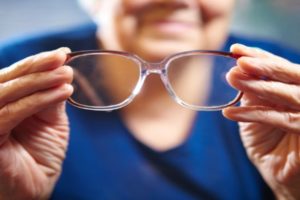More than 12 million Americans aged 40 years and older experience vision impairment, and with an aging American population this number is expected to double by 2050.1 Each year, one in four Americans 65 and older experiences a fall, the leading cause of injury among older adults2, and impaired vision more than doubles this risk.3 Falls often result in serious injuries, decreased mobility, and loss of independence.
Know the Risk
Older adults with impaired vision or who are at risk for vision impairment often have other chronic illnesses, such as diabetes, stroke, and heart disease, which also increase the risk of falling.4 These chronic conditions are associated with the use of prescription drugs that have side effects, such as dizziness and muscle weakness, which can increase fall risk. Furthermore, older adults with vision impairment can be socially isolated and may take on physical tasks they cannot easily perform alone, increasing the risk of injury from falls and making it more challenging to get help if they do fall. Additionally, insulin use is associated with an increased risk of hypoglycemia (low blood sugar), which is often accompanied by blurred vision, dizziness, and weakness, further increasing fall risk.5
Falling and vision impairment are among the most common fears for older adults. If you are afraid of falling, you are not alone. Falls are preventable, and strategies for reducing risk and slowing the progression of vision impairment may help prevent falls and related consequences for older people. Therefore, older Americans should make sure to take the necessary steps to protect their vision and reduce their chance of falls.
Preventing Falls
Doing just one of the following could prevent a fall:
Do exercises to improve strength and balance, such as tai chi.
Wear sturdy, non-slip footwear that fits correctly to help with balance and mobility, and reduce injury to ankles.
Get a dilated eye exam at least once a year to reduce the risk of irreversible vision loss and update glasses if needed.
Talk to your doctor about evaluating risk for vision impairment and/or falls and how to prevent falls. Health care providers should review medications periodically to see if side effects, such as drowsiness or dizziness, could increase the risk of falls.
Make the home safer:
- Remove throw rugs or use double-sided tape to keep them from slipping.
- Make sure all rooms and hallways are well lit and have easily accessible switches or motion sensor lights.
- Install handrails on stairs and grab bars in the bathroom/shower.
1. Varma R, Vajaranant TS, Burkemper B, et al. (2016). Visual impairment and blindness in adults in the United States: Demographic and geographic variations from 2015 to 2050. JAMA Ophthalmol, 134(7), 802-809.
2. Bergen G, Stevens MR, Burns ER. Falls and Fall Injuries Among Adults Aged ≥65 Years — United States, 2014. Morb Mortal Wkly Rep 2016;65:993–998. DOI: https://dx.doi.org/10.15585/mmwr.mm6537a2external icon
3. National Academies of Sciences, Engineering, and Medicine. (2017). Making eye health a population health imperative: Vision for tomorrow. National Academies Press.
4. Crews, JE (2016). Falls among persons aged≥ 65 years with and without severe vision impairment—United States, 2014. Morb Mortal Wkly Rep, 65.
5. Kachroo S, Kawabata H, Colilla S, et al. (2015). Association between hypoglycemia and fall-related events in type 2 diabetes mellitus: analysis of a US commercial database. J Manag Care Spec Pharm, 21(3), 243-253.
_
source: cdc.gov/visionhealth/resources/features/vision-loss-falls.html

